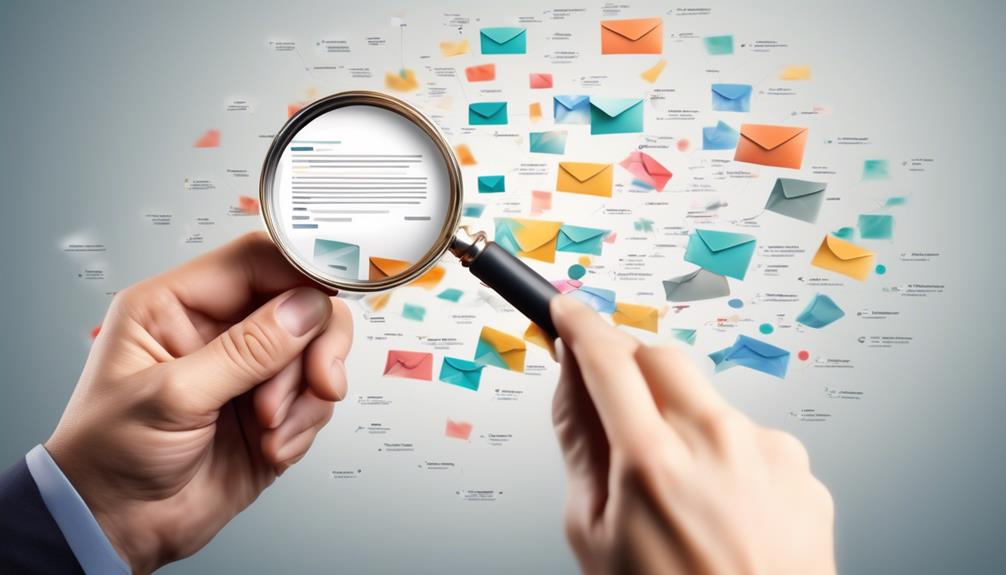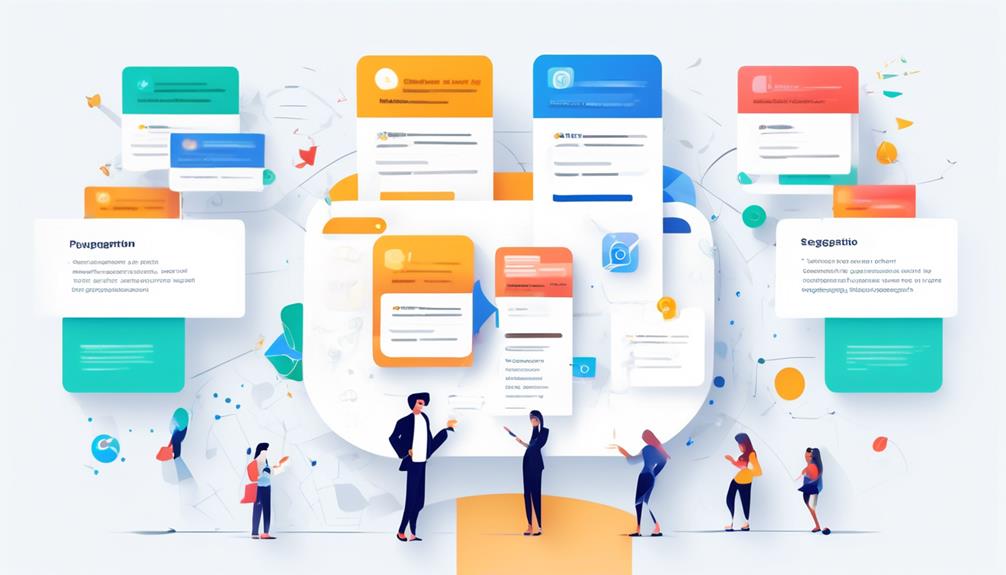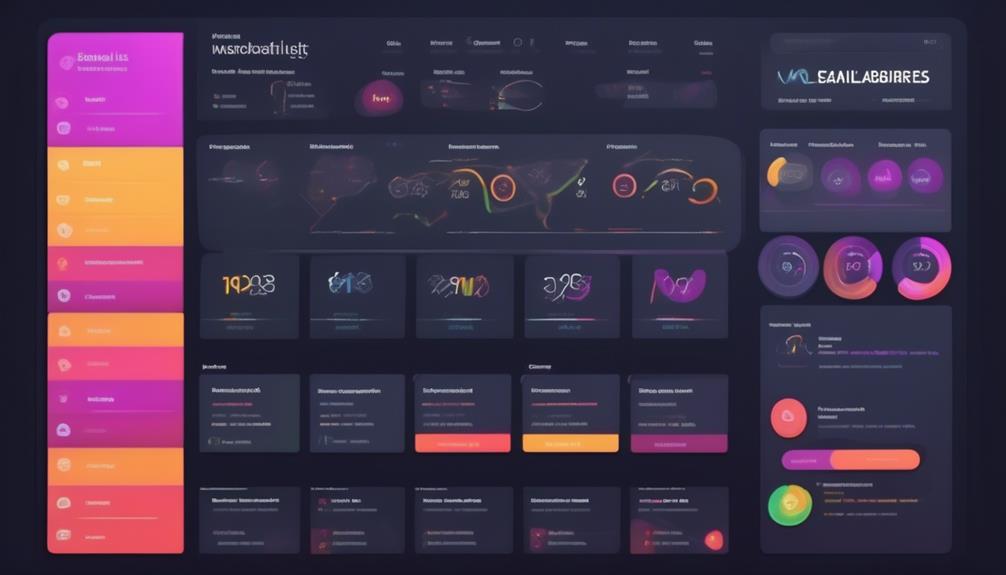Splitting an email list into segments is like crafting a masterpiece; each stroke of color reveals the distinctive charm of the whole picture. As marketers, we understand the importance of engaging with our audience through personalized messages that resonate with their individual preferences and behaviors.
However, in the vast landscape of email marketing, how do we effectively navigate the terrain of segmentation to ensure our efforts yield the desired results?
Join us as we explore the intricate strategies and proven techniques that can elevate your email marketing game to new heights, driving engagement and conversions like never before.
Key Takeaways
- Email segmentation is crucial for targeting and personalizing campaigns, leading to higher engagement and conversion rates.
- Behavioral segmentation allows for personalized content delivery based on past interactions, improving the effectiveness of campaigns.
- Analyzing open rates and click-through rates helps refine email content and optimize send times, increasing the overall performance of campaigns.
- Targeting inactive subscribers through personalized re-engagement campaigns can improve overall email list engagement and conversion rates.
Understanding Email Segmentation
Understanding email segmentation is crucial for effectively targeting and personalizing email campaigns to maximize engagement and conversion rates. By segmenting your email list, you can tailor your marketing strategies to specific groups within your customer base. This allows for the creation of personalized emails that resonate with the unique needs and preferences of each segment.
When segmenting your email list, consider using buyer personas and segmentation ideas to nurture leads throughout the customer journey. This approach ensures that the right content is delivered to the right audience at the right time, increasing the likelihood of conversions.
Segmentation is the key to unlocking the full potential of your email marketing efforts. It's like having a conversation with each segment individually, rather than broadcasting a generic message to your entire list. This level of personalization and precision is what sets effective email campaigns apart.
Benefits of Segmentation

What benefits does segmentation bring to email marketing campaigns, and how can it enhance the overall effectiveness of our outreach efforts?
Email list segmentation in marketing offers numerous advantages. By dividing our email list into smaller segments, we can send more relevant, targeted content to our customers. This tailored approach increases the resonance of our emails, leading to higher engagement rates. Segmented campaigns have been shown to improve open and click-through rates, as the content is specifically tailored to the interests and needs of each segment.
Moreover, relevant content significantly increases the likelihood of recipients taking the desired action, ultimately leading to better conversion rates. Additionally, segmentation helps us avoid sending generic messages, reducing the chances of subscribers unsubscribing and thus decreasing unsubscribe rates. Furthermore, personalized emails not only improve customer satisfaction but also enhance customer loyalty, contributing to better customer retention.
Therefore, by sending segmented emails, we can deliver more personalized, targeted content that resonates with specific groups of subscribers, ultimately enhancing the effectiveness of our email marketing campaigns.
Demographic Segmentation
We're about to explore the effectiveness of demographic segmentation in email marketing.
Age-based segmentation allows us to tailor content that resonates with different age groups.
Gender-based segmentation enables us to craft messaging that speaks directly to the unique preferences and needs of different genders.
Age-Based Segmentation
By segmenting our email list based on age, we can tailor our content and offers to resonate with specific age groups, allowing for personalized communication and targeted messaging. Age-based segmentation is a crucial aspect of demographic segmentation for email marketing. It enables us to create segments based on different age ranges, ensuring that our emails are relevant and engaging for each group. To effectively segment your customers, it's essential to identify key age brackets and understand the preferences and behaviors associated with each group. Sending targeted emails to these segments based on age-specific interests and needs can significantly enhance engagement and conversion rates. Below is a table illustrating the significance of age-based segmentation in email marketing:
| Age Group | Characteristics |
|---|---|
| Millennials | Tech-savvy, value experiences |
| Gen X | Family-oriented, career-focused |
| Baby Boomers | Value security, traditional |
| Gen Z | Digital natives, socially conscious |
| Seniors | Value simplicity, health-focused |
Gender-Based Segmentation
Gender-based segmentation is a valuable strategy that allows marketers to tailor their email content to resonate with specific genders within their audience, leading to more targeted and relevant messaging. When implementing gender-based segmentation in email list segmentation strategies, it's essential to create separate segments according to the gender of your email recipients. This enables you to send the most relevant and personalized content to each group.
Marketers can use this strategy to understand and address the unique needs and behaviors associated with different genders, enhancing the effectiveness of their marketing efforts. By segmenting your list based on gender, you can craft campaigns that resonate with the diverse interests and characteristics of your male and female subscribers, ultimately driving higher engagement and conversion rates.
Behavioral Segmentation

A powerful approach to enhancing email list segmentation is behavioral segmentation, which involves dividing the email list based on past interactions and behaviors such as purchase history, product usage, and website interactions. This valuable tool allows for personalized content delivery based on specific behaviors, increasing relevance and engagement.
By segmenting subscribers based on their behavior, marketers can send tailored emails that cater to individual preferences and interests, improving the effectiveness of email marketing campaigns. Behavioral segmentation enables targeted messaging to specific groups based on their past actions. This strategy helps in delivering the right message to the right audience at the right time, leading to higher conversions and engagement.
Marketers can use behavioral segmentation to send emails based on how recipients interact with their emails, ensuring that the content resonates with the recipient's interests. It's a strategic segmentation strategy that can significantly enhance the impact of email marketing campaigns and improve the overall experience for email recipients.
Email Engagement Level
Let's talk about how analyzing open rates can help us understand which subscribers are most engaged with our emails.
We can also explore how segmenting based on click-through rates can lead to more targeted campaigns.
Additionally, we'll discuss strategies for re-engaging inactive subscribers to boost overall engagement levels.
Open Rate Analysis
Open Rate Analysis is an essential tool for evaluating the engagement level of email subscribers, providing valuable insights into their interests and interactions with the content.
When analyzing open rates, we can identify trends and patterns, enabling targeted adjustments to improve engagement levels.
Segmentation based on open rates allows us to differentiate highly engaged subscribers and those needing re-engagement efforts, facilitating tailored communication.
Understanding open rates helps gauge the effectiveness of subject lines, content, and overall email strategy, leading to refined email content and optimized send times.
By utilizing open rate analysis, we can send more targeted and personalized emails, ultimately increasing the overall performance of our email campaigns.
This approach also contributes to enhancing the Net Promoter Score (NPS) by fostering stronger connections with email recipients.
Click-Through Rate Segmentation
As we aim to enhance our email marketing strategy, understanding the click-through rate segmentation becomes pivotal for effectively targeting subscribers based on their interaction levels with our emails. This segmentation strategy allows us to categorize email recipients into highly engaged and less engaged segments, enabling us to tailor our approach accordingly.
Highly engaged leads may receive exclusive content or offers, while less engaged ones may be re-engaged with personalized content. By analyzing click-through rates, we can gauge the effectiveness of our email campaigns and refine our strategies to boost engagement.
Utilizing click-through rate segmentation is the practice of delivering personalized and targeted messaging to improve overall email performance. This enables us to effectively segment our audience and deliver content that resonates, ultimately driving better results on our marketing platform.
Inactive Subscriber Targeting
Targeting inactive subscribers through personalized re-engagement campaigns is crucial for revitalizing their interest and increasing overall email list engagement.
When implementing inactive subscriber targeting, we focus on:
- Creating segments for highly engaged subscribers and those who rarely interact with emails.
- Tailoring specific re-engagement campaigns to inactive subscribers, aiming to bring them back into the active engagement fold.
- Reviving interest and interaction from subscribers who've become disengaged over time.
- Improving overall email list engagement and potentially increasing conversion rates.
Effective Segmentation Strategies

To effectively segment an email list, it is crucial to personalize content for each segment in order to increase engagement and conversion rates. By creating different email list segments based on target audience, we can use email list segmentation to send relevant emails, tailoring our content to the specific needs and interests of each segment. This email segmentation strategy allows us to use data to send more personalized and targeted communications, leading to higher open rates and improved customer satisfaction.
| Segment Based on Target Audience | Use Data to Send | Send Relevant Emails |
|---|---|---|
| Demographic, geographic, behavioral, and preference-based segmentation | Utilize segmentation tools and software | Employ dynamic content, behavioral triggers, and personalized recommendations |
Frequently Asked Questions
What Is Segmentation Strategy in Email Marketing?
Segmentation strategy in email marketing involves dividing the email list into smaller, targeted groups to send personalized and relevant content. It enables us to tailor email campaigns, leading to higher engagement and conversion rates.
Precise targeting ensures the right message reaches the right people at the right time. This strategy is essential for successful marketing campaigns, ensuring subscribers receive content that resonates with their interests and needs.
How Should I Segment My Email Lists?
When segmenting our email lists, we focus on personalized content to boost engagement. 72% of consumers say they only engage with personalized messaging.
We tailor our segments based on demographics, behavior, and interests, ensuring relevant content reaches the right audience.
We use dynamic content to adapt emails based on user behavior. By doing this, we see increased open and click-through rates, leading to higher conversions and customer satisfaction.
What Is the Most Effective Email Marketing Campaign Strategy?
The most effective email marketing campaign strategy involves segmentation to send targeted emails tailored to smaller groups, increasing relevance and engagement. This ensures the right message reaches the right people, leading to improved open and click-through rates and better conversion rates.
Strategies include demographic, geographic, and behavioral segmentation, as well as segmenting based on email engagement level, purchase history, and customer loyalty.
Tools for segmentation include built-in features in popular email service providers, CRM systems, marketing automation platforms, and third-party plugins and integrations.
Email segmentation also involves dynamic content, personalized recommendations, re-engagement campaigns, and personalized subject lines to enhance engagement and drive conversions.
Why Would a Marketer Segment Their Email Marketing Lists?
We segment our email marketing lists to deliver personalized and relevant content, increasing engagement and conversions.
Tailoring our messaging and offers to different audience segments improves the chances of resonating with recipients and driving desired actions.
By avoiding generic messages to our entire audience, we reduce the likelihood of unsubscribes and increase customer satisfaction.
Effective segmentation allows us to better understand our audience's preferences, behaviors, and needs, creating more targeted and effective marketing campaigns.
What are the Most Effective Email List Segmentation Strategies for Marketers?
When it comes to reaching the right audience with your email marketing campaigns, using effective email list segmentation strategies is key. By categorizing your subscribers based on their behaviors, demographics, or interactions with your brand, you can tailor your messages to their specific interests and preferences, resulting in higher engagement and conversions.
Conclusion
In conclusion, implementing effective email list segmentation is like having a secret weapon in our marketing arsenal. By understanding our audience and tailoring our content to their specific needs and interests, we can significantly boost our conversion rates and engagement levels.
With the right segmentation strategies in place, we've the power to deliver personalized and targeted messages that resonate with our subscribers, ultimately leading to the success of our email campaigns.










